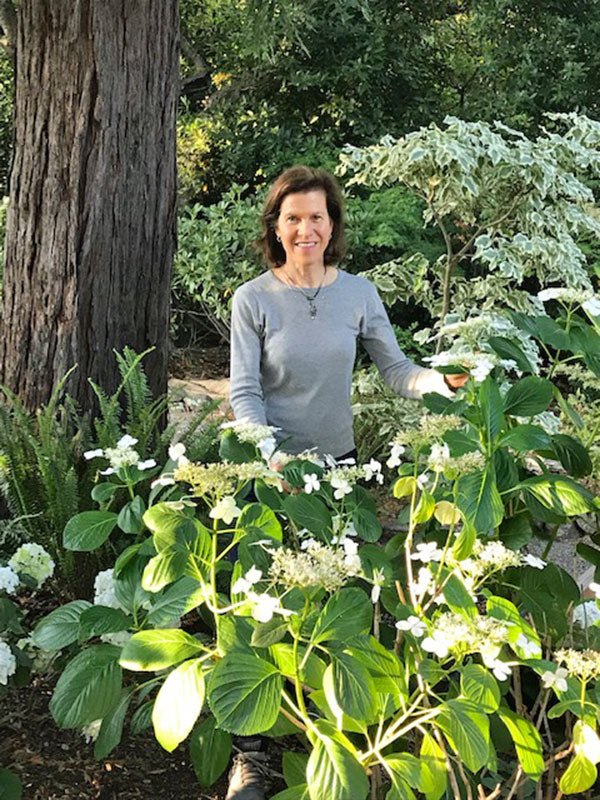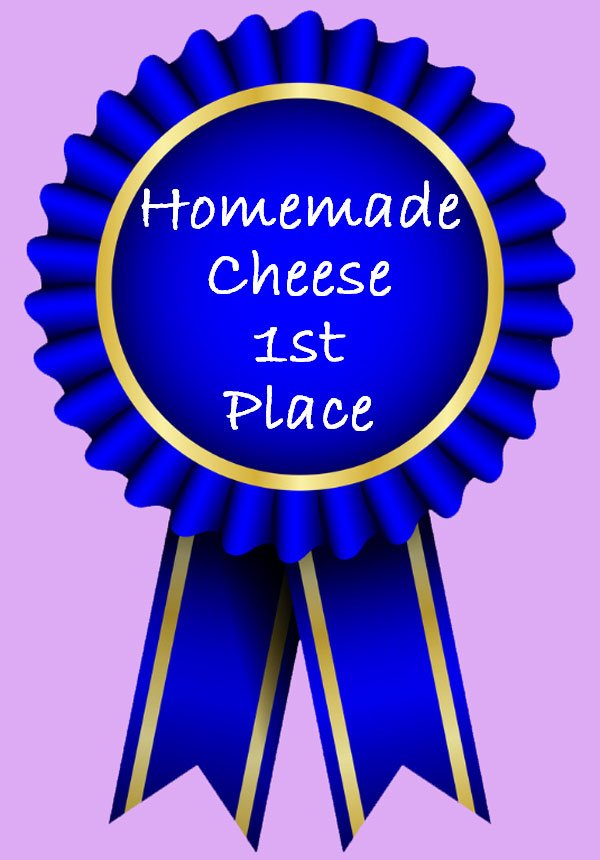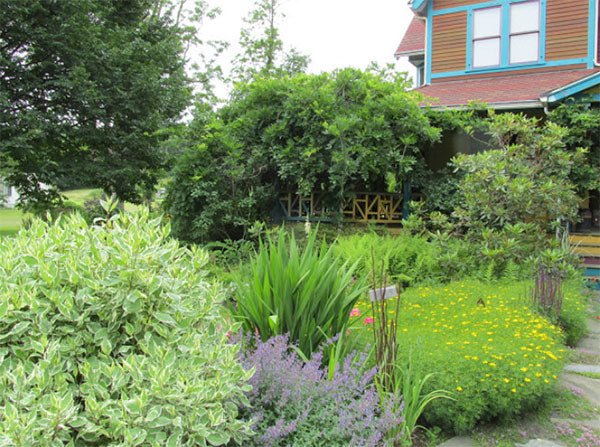
Susan Bates
She’s living in paradise! It’s hard to imagine a lovelier location for growing food and making cheese. No wonder her first raw milk chevre looked fabulous!

First chèvre with violas and lavender from the garden.
Susan’s Story
We’re in the Town of Hillsborough, California, located on the San Francisco Peninsula, centered between SF and San Jose and the SF Bay and Pacific coast. Our half-acre property includes: a modest vegetable garden; fruit trees; numerous roses, Japanese maples, dogwoods and other ornamentals and some very mature oaks and redwoods.

All of my (50 or so) floribunda and David Austin roses are continuous bloomers, so deadheading is a daily necessity. Roses bloom here most of the year.

Julia Child roses, aptly named for the color of butter.

Our redwood grove — underplanted with hydrangeas, dogwoods, rhodies, hostas and Japanese maples.

Zucchini, lavender, pumpkins and melons.

The pumpkins end up taking over the beds.

2017 pumpkin harvest (I set them on egg and berry cartons in Fall to keep them dry).


This is how I use wine barrels as raised beds.

Sugar babies — “minis” but still 8-9 lbs!


Preserved lemons and limes and fermenting classic kraut and plums.
My interest in learning to make cheese at home was fueled by several things, but what finally prompted me into action in 2018 was my growing interest in raw dairy and my recent access to very high quality raw milk.
I’d been participating in a local raw Jersey and Guernsey (A-2 certified) cow herdshare program for about a year, and also a local Golden Guernsey goat rancher had begun selling raw goat milk at my farmers market (his is an organic, inspected facility).

These are Scottish Belted Galloways at Markegard Grassfed in Half Moon Bay where I’m a member of their meat CSA (beef, lamb, pork and chicken).

Their sheep and llamas.

Daisy, one of their 3 Jersey milk cows. We were in their herdshare program for raw milk until it ended. Daisy produced incredible milk.
These two milks were so readily available that I thought it would be fun to make my own cheese with them. (Unfortunately the cow herdshare program was recently terminated, although there are two other sources of raw cow milk and cream (one Jersey, the other Holstein) that I can find at most high-end grocers in my area; I also use Straus low-heat pasteurized organic whole milk on occasion — often when experimenting or when making cheese for a group gathering due to lower cost.)
Some other factors that played into my interest were:
– the unavailability of fresh raw milk cheese and other fermented dairy due to government regulations
– a 2017 trip to Normandy and Paris where I enjoyed many great French cheeses
– continued focus on healthy whole food ingredients — both vegetable and animal
– lifelong love of the kitchen and learning new food skills
– adoration of all things dairy!
A few years ago I’d begun fermenting foods – first kraut, then other vegetables and fruit, and vinegar. Then, in 2018, I was invited to do some recipe testing for an upcoming book by Russ Crandall about ancestry and traditional foods and recipes and for that project I learned how to make wild fermented sourdough from 100% einkorn.

My first batches of einkorn sourdough starter.
That experience prompted me to continue my sourdough pursuits and I made many different breads with all einkorn, including sandwich style and artisan loaves, bagels, Irish soda bread, and challah-type braided loaves.



Bagels.

Irish soda bread.

Challah type bread.
Reading through fermentation books got me thinking about cheese and it became another skill that I wanted to learn. After researching about local courses, I took a few introductory classes and learned a little about milk structure, cultures, and the basic steps of all cheese making. Then I bought a few good books and started teaching myself how to make other things like raw cultured butter, creme fraiche, buttermilk, whey ricotta, etc.

Fromage blanc.

First raw creme fraiche.

Used some of the creme fraiche to churn raw cultured butter.

First time making cream cheese (half & half and Aroma B). Later I whipped and packed in tubs. Much better than store bought!

Whey ricotta with apricots and honey for dessert.
Since then, I’ve made various surface ripened and fresh cheeses on a pretty regular basis. My primary constraint is not having enough mouths to feed it to. (Another reason that I don’t bake as much as I’d like to.) It’s just my husband and me, and we can’t eat all of the cheese that I’d like to make. Of course I do share it with good friends and some of my favorite farmers and ranchers.

Chèvre with chives.

Pasteurized cow milk Brie.

Raw goat milk Valencay.

Organic Jersey Brie and friends for company.
I’m also in need of a dedicated wine refrigerator for aging if I want to expand my production. We have a huge wine fridge, but I have to squeeze my aging onto just part of the top shelf because it’s stuffed with wine.

My wine (and cheese) cellar…this limits how much cheese that I can make at one time.

One of my ripening boxes. It doubles as a draining box because the basket is slightly raised and lifts out with one hand while I dump out the whey with the other hand. It has a lid with a slider insert that allows for circulation (or not).

Another type of ripening box that I use for small cheeses.
We’ve enjoyed all of the cheeses that I’ve made thus far, but my attempts at Valencay top our list.

My ashed raw goat Brie might run a close 2nd.

First time making ash ripened cheese (raw goat Brie).
A new discovery that I’m fond of is “lache” – I call it that (instead of chèvre or fromage blanc) because it’s a hybrid – cow milk cultured with C20G chèvre culture. It’s not as tangy as chèvre yet surprisingly good!
I’ve been unable to find more advanced courses locally, but I’ve been researching some offered in the US and abroad. I look forward to doing that!

Chocolate goat cheese cheesecake that I made for Christmas in 2017.
My husband is very helpful and supportive, especially with irrigation and amending in the garden, eating the bounty and sampling my cheese. We don’t have chickens because organic all-pastured eggs from local ranchers are readily available. I’d love to own goats, sheep and a Jersey cow (obvious reasons!), and horses, but that would curtail future travel and require a home move due to our town’s zoning restrictions.
Beyond food and gardening, creative and fiber arts have been my lifelong hobbies — mainly designing, sewing, knitting, crocheting and jewelry-making. My husband enjoys cycling and fly fishing. Together we like to hike and travel.

Hiking in Vail, Colorado
Most recently, we’ve traveled to France (previously mentioned), Bainbridge Island, the gorgeous San Juan Islands, and Vail & Boulder, Colorado. In France and the San Juans we toured the countrysides on our portable tandem bicycle.
In September we’re heading to Provence with a culinary-focused group staying at the former homes of Simone Beck and Julia Child, about 30 minutes from Nice. (We’re hoping to stop at the Bra Italy cheese festival beforehand because it’s not far from Nice!)
I’d like to plan some future trips around cheese making courses in the US and Europe, including the Loire region of France – we adore their goat cheeses and so far I’ve made their Crottin de Chevignol and Valencay using Jim’s recipes and forms and supplies from NECS with good success.

Roses are David Austin’s Carding Mill.














































































































































